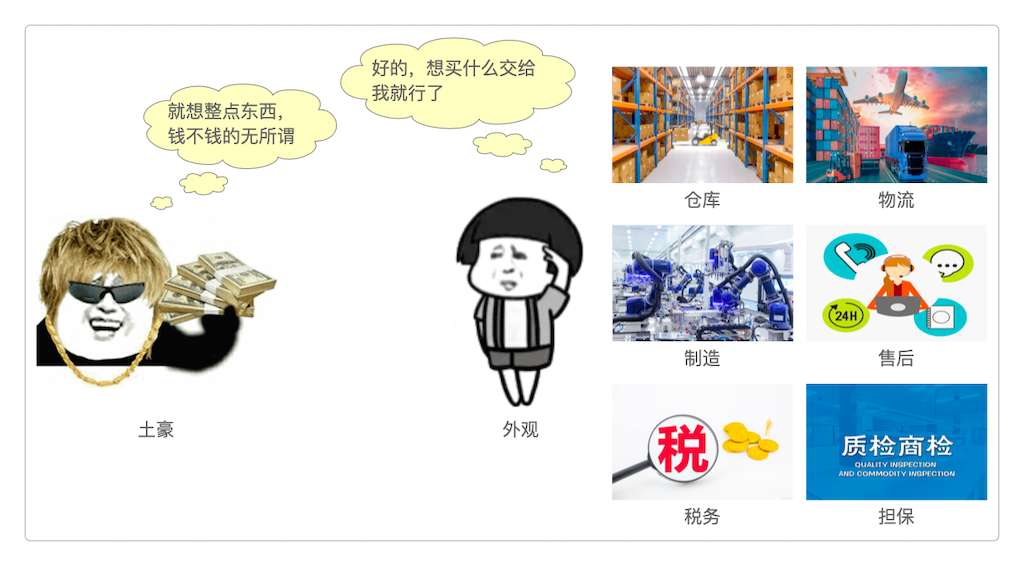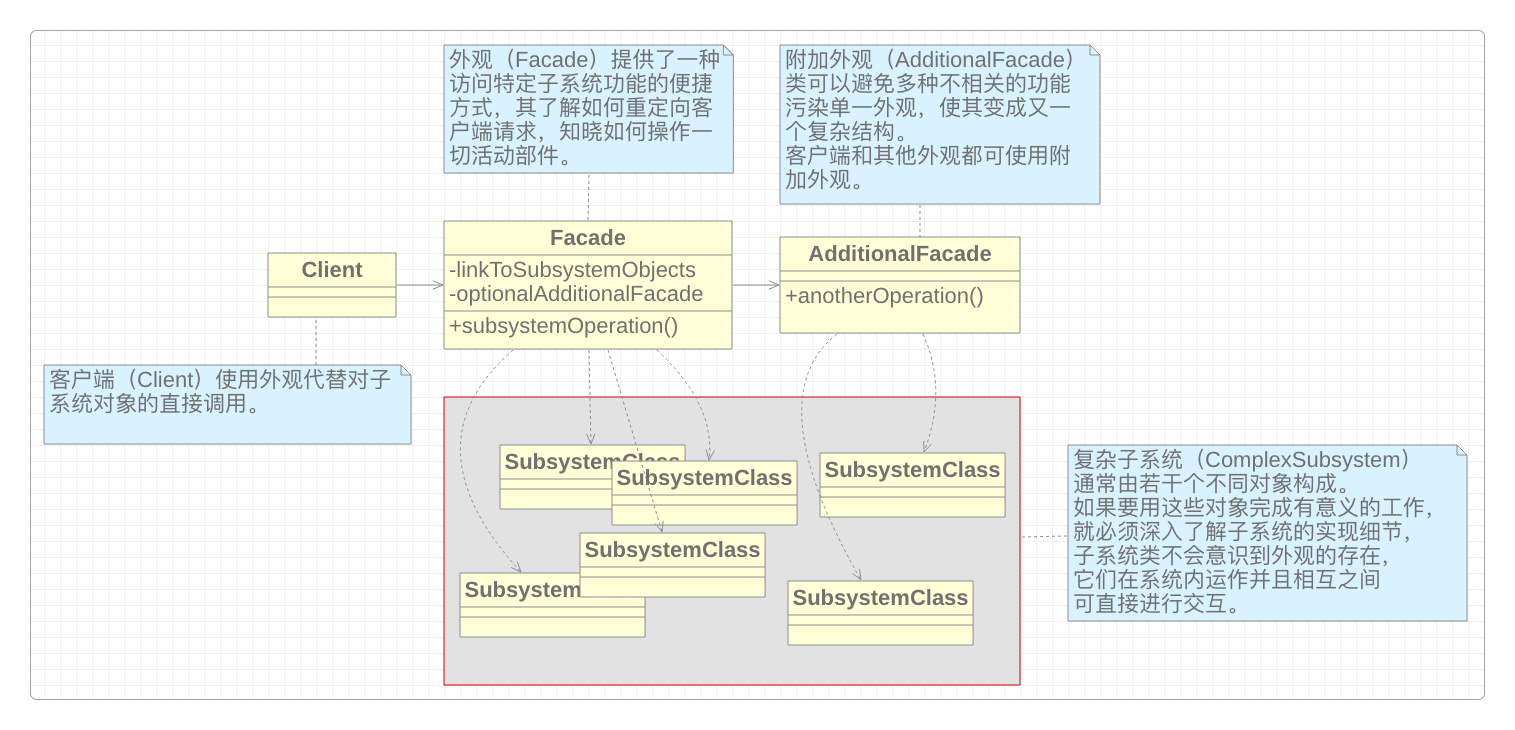外观模式(结构型模式)
模式概述
外观模式有的地方又叫门面模式,是一种结构型设计模式,为程序库、 框架或其他功能复杂的类提供一个统一的、简单的访问接口。
问题
大多数程序员都有过开发复杂应用的经历,不仅需要负责所有对象的初始化,还得管理其依赖关系并按正确的顺序执行方法等。
而代码中的业务逻辑又常与第三方类的实现细节紧密耦合,使得理解和维护代码的工作很难推进。
方案
通过一个简单的接口,来包含众多复杂子系统的各个功能。这与直接调用众多的子系统相比,既简化了调用过程中的繁杂操作(例如初始化、依赖管理及执行顺序),又将客户端真正关心的功能给呈现出来。

结构

实现
Java
/**
* 视频文件
*
*/
public class VideoFile {
private String name;
private String codecType;
public VideoFile(String name) {
this.name = name;
this.codecType = name.substring(name.indexOf(".") + 1);
}
public String getCodecType() {
return codecType;
}
}
/**
* 编码接口
*
*/
public interface Codec {
}
/**
* MP4编码
*
*/
public class MPEG4Codec implements Codec {
public String type = "mp4";
}
/**
* OGG编码
*
*/
public class OggCodec implements Codec {
public String type = "ogg";
}
/**
* 编码工厂
*
*/
public class CodecFactory {
public static Codec extract(VideoFile file) {
String type = file.getCodecType();
if (type.equals("mp4")) {
System.out.println("正在转换mp4为音频...");
return new MPEG4Codec();
} else {
System.out.println("正在转换ogg为音频...");
return new OggCodec();
}
}
}
/**
* 读取器
*
*/
public class BitrateReader {
public static VideoFile read(VideoFile file, Codec codec) {
System.out.println("正在读取视频文件...");
return file;
}
public static VideoFile convert(VideoFile buffer, Codec codec) {
System.out.println("正在写入视频文件...");
return buffer;
}
}
/**
* 音频修复
*
*/
public class AudioMixer {
public File fix(VideoFile result){
System.out.println("正在修复音频...");
return new File("tmp");
}
}
/**
* 门面
*
*/
public class VideoConversionFacade {
public File convertVideo(String fileName, String format) {
System.out.println("视频转换开始...");
VideoFile file = new VideoFile(fileName);
Codec sourceCodec = CodecFactory.extract(file);
Codec codec;
if (format.equals("mp4")) {
codec = new MPEG4Codec();
} else {
codec = new OggCodec();
}
VideoFile buffer = BitrateReader.read(file, sourceCodec);
VideoFile intermediateResult = BitrateReader.convert(buffer, codec);
File result = (new AudioMixer()).fix(intermediateResult);
System.out.println("视频转换完成...");
return result;
}
}
/**
* 客户端
*
*/
public class Client {
public static void main(String[] args) {
VideoConversionFacade converter = new VideoConversionFacade();
File mp4Video = converter.convertVideo("test.ogg", "mp4");
}
}Go
package main
import "fmt"
/**
* “钱包”外观
*
*/
type WalletFacade struct {
account *Account
wallet *Wallet
securityCode *SecurityCode
notification *Notification
ledger *Ledger
}
func newWalletFacade(accountID string, code int) *WalletFacade {
fmt.Println("Starting create account")
walletFacacde := &WalletFacade{
account: newAccount(accountID),
securityCode: newSecurityCode(code),
wallet: newWallet(),
notification: &Notification{},
ledger: &Ledger{},
}
fmt.Println("Account created")
return walletFacacde
}
func (w *WalletFacade) addMoneyToWallet(accountID string, securityCode int, amount int) error {
fmt.Println("Starting add money to wallet")
err := w.account.checkAccount(accountID)
if err != nil {
return err
}
err = w.securityCode.checkCode(securityCode)
if err != nil {
return err
}
w.wallet.creditBalance(amount)
w.notification.sendWalletCreditNotification()
w.ledger.makeEntry(accountID, "credit", amount)
return nil
}
func (w *WalletFacade) deductMoneyFromWallet(accountID string, securityCode int, amount int) error {
fmt.Println("Starting debit money from wallet")
err := w.account.checkAccount(accountID)
if err != nil {
return err
}
err = w.securityCode.checkCode(securityCode)
if err != nil {
return err
}
err = w.wallet.debitBalance(amount)
if err != nil {
return err
}
w.notification.sendWalletDebitNotification()
w.ledger.makeEntry(accountID, "debit", amount)
return nil
}
/**
* 账户
*
*/
type Account struct {
name string
}
func newAccount(accountName string) *Account {
return &Account{
name: accountName,
}
}
func (a *Account) checkAccount(accountName string) error {
if a.name != accountName {
return fmt.Errorf("账户名不正确")
}
fmt.Println("账户被核实")
return nil
}
/**
* 安全码
*
*/
type SecurityCode struct {
code int
}
func newSecurityCode(code int) *SecurityCode {
return &SecurityCode{
code: code,
}
}
func (s *SecurityCode) checkCode(incomingCode int) error {
if s.code != incomingCode {
return fmt.Errorf("安全码不正确")
}
fmt.Println("安全码被核实")
return nil
}
/**
* 钱包
*
*/
type Wallet struct {
balance int
}
func newWallet() *Wallet {
return &Wallet{
balance: 0,
}
}
func (w *Wallet) creditBalance(amount int) {
w.balance += amount
fmt.Println("钱包余额增加成功")
return
}
func (w *Wallet) debitBalance(amount int) error {
if w.balance < amount {
return fmt.Errorf("余额不足")
}
fmt.Println("余额不足")
w.balance = w.balance - amount
return nil
}
/**
* 分类账户
*
*/
type Ledger struct {
}
func (s *Ledger) makeEntry(accountID, txnType string, amount int) {
fmt.Printf("为税务 %s 类型账户 %s 充值 %d 元\n", txnType, accountID, amount)
return
}
/**
* 通知
*
*/
type Notification struct {
}
func (n *Notification) sendWalletCreditNotification() {
fmt.Println("发送钱包信用通知")
}
func (n *Notification) sendWalletDebitNotification() {
fmt.Println("发送钱包借记通知")
}
/**
* 客户端
*
*/
func main() {
fmt.Println()
walletFacade := newWalletFacade("abc", 1234)
fmt.Println()
err := walletFacade.addMoneyToWallet("abc", 1234, 10)
if err != nil {
fmt.Errorf("Error: %s\n", err.Error())
}
fmt.Println()
err = walletFacade.deductMoneyFromWallet("abc", 1234, 5)
if err != nil {
fmt.Errorf("Error: %s\n", err.Error())
}
}适用场景
如果需要直接操作复杂子系统的接口,且该接口的功能有限,则可以使用外观模式。
当客户端与多个子系统之间存在很大的依赖性时,可引入外观模式将客户端与子系统解耦。
在多层次结构中,可通过外观模式定义系统中每一层的入口,降低层之间的耦合度。
优缺点
外观模式的优点。
为客户端屏蔽了子系统的复杂性,实现了子系统与客户端之间的解耦。
降低了大型软件系统中的编译依赖性,并简化了系统在不同平台之间的移植过程。
外观模式的缺点。
- 外观类可能成为与程序中所有类都耦合的上帝对象。
相关性
当需要对客户端隐藏子系统创建对象的方式时,可以使用
抽象工厂模式来代替外观模式。外观模式为现有对象定义一个新接口,通常会作用于整个对象子系统上;适配器模式则会封装已有的接口,且仅封装单个对象。代理模式与外观模式的相似之处在于都封装了另一个实体并对其进行初始化,但代理模式可与服务对象互换,而外观模式不行。享元模式展示了如何生成大量的小型对象,而外观模式则展示了如何用一个对象来代表整个子系统。外观模式和中介者模式的职责类似,它们都尝试在大量紧密耦合的类中组织起合作。外观模式通常可以转换为单例模式,因为大部分情况下单个外观类就足够了。当只需要对客户端隐藏子系统的实现细节时,可以用
抽象工厂模式来代替外观模式。
感谢支持
更多内容,请移步《超级个体》。
